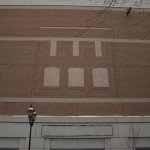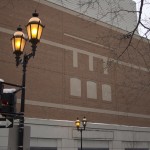

In 1991, Richard Purdy founded the Les industries perdues collective; François Hébert joined the same year. Each has a master’s degree in visual arts and a good number of solo exhibitions to his credit. Truly integrated into the urban environment and deliberately narrative in nature, their artworks appropriate objects by slipping them into an existing or invented mythical context. Among their productions are L’Horizon vertical (1997) at Théâtre de Nouveau Monde, Deus ex machina (1995) at Usine C, and La vivrière (1995) in Place de la FAO in Québec City.
Richard Purdy studied at the Nova Scotia College of Art and Design in Halifax, then pursued a Master’s in Arts at the Villa Schifanoia Badia Fiesolana in Florence and a Doctorate’s in the studies and practices of art at UQAM in 2000. He also teaches visual art and art history in the UQTR’s Département des arts while directing research projects. He has published more than twenty papers.
In 1991, Richard Purdy founded Les Industries Perdues. The collective created 19 public art projects, including pieces for the United Nations, Quebec City, the STCUM, Cirque du Soleil, Télé-Québec, Ahuntsic Cégep, the Théatre du Nouveau Monde, the Carbone 14’s Usine ”C” and the place Gérard-Godin in front of the Mont-Royal metro station in Montreal. The artist participated in over a hundred solo or collective exhibits in France, Great Britain, the United States, Germany, Australia and of course in Quebec and Canada. In 2010, he showcased his work at the Espace Shawinigan, an exhibit which regrouped four very large installations.
Richard Purdy does as much performance art, paintings, installation as sculpture and works with researchers in other disciplines. Interdisciplinary work is important to him because it presents a subject in many different points of view. This artist loves to surprise his public and plays on ambiguity and illusions. Purdy also subverts systems that melt reality because, as he put it, ”my goal is not to create the new, but to discover what has been forgotten.” He also explored on many occasions the theme of stupa, particularly in the performing arts and dance. He believes that one must experience an object in order to understand its fundamental meaning.

- 17 Artworks
- 1h
- Berri-UQAM metro station
 Saint-Laurent metro station
Saint-Laurent metro station 
Artwork description
A visual interlude inserted discreetly into the architecture, the artist’s intervention rests in the installation, orientation and projection of the brick and ornamental stone. Their embossed positioning ensures that the boundaries of the work are only visible at certain times of day, depending on the position of the sun which gives rythmn to the visual cadence. The shape of the work is based on that of the facade of the first Montreal School of Fine Arts, which occupied the land on which now stands the Centre Pierre-Péladeau, the latter therefore haunted by this architectural past.


